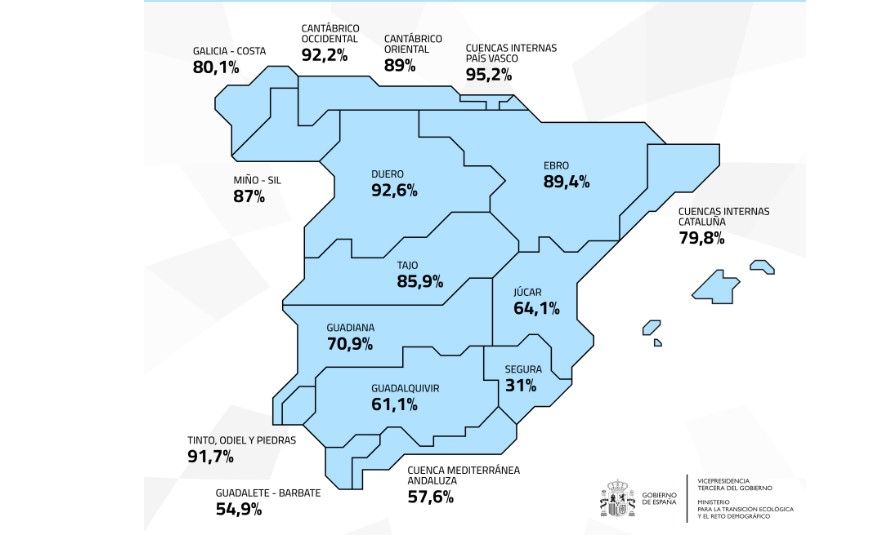Water reserves in Spain continue to rise, now recording their twelfth consecutive week of growth. Last week, reservoir capacity increased by 0.33 percentage points, bringing the total to 77.4% of their capacity. This is the highest level in 11 years. The last comparable level was in week 33 of the 2013-2014 hydrological year, when reserves exceeded 80%.
This trend is confirmed by data released on Tuesday by the Ministry for Ecological Transition. The ministry publishes weekly updates on reservoirs. According to the data, rainfall over the past seven days was “abundant” across the entire Iberian Peninsula, with a peak of 55.8 liters per square meter in Lugo. This rainfall led to an increase in the total water reserve of 173 cubic hectometers, meaning the reservoirs now hold a total of 43,407 cubic hectometers of water.
Thanks to the rainfall of the last few months, the water reserves situation is significantly different than it was a year ago. At the same time last year (2023), the reservoirs stored 37,100 cubic hectometers, corresponding to a capacity of 66.3% – and thus 11 percentage points below current levels.
The comparison with the ten-year average for the same calendar week is similarly positive. This average is 35,600 cubic hectometers (63.6%), which means the current reserves are an impressive 15 percentage points higher.
Tagus Basin Reaches New Record
Not only is the total water reserve at its highest level in recent years, but the analysis of the water levels in the peninsula’s 16 individual catchment areas also paints a positive picture. The Tagus Basin even recorded a new historic record this week. After an increase of 0.24 percentage points, it now reaches 85.92% of its capacity.
The inland basins of the Basque Country once again lead the way in terms of water levels, with 95.2% of their capacity. This is followed by Western Cantabria (92.2%), the Duero Basin (92.6%), Tinto, Odiel, and Piedras (91.7%), the Ebro Basin (89.4%), and Eastern Cantabria (89%).
Other high water levels are recorded in the Miño-Sil (87%) and Galicia Costa (80.1%). The south and east of the peninsula are also reporting encouraging figures. While Catalonia was still struggling with drought a year ago and its reservoirs were only about 25% full, this week the figure is almost 80%. The Júcar Basin reached 64%, and the Guadiana Basin rose to 70.9%.
Although the southern basins continue to have the lowest water levels compared to the north, the situation here has also improved compared to previous, significantly lower water levels. The Guadalquivir basin is at 61.1%, the Guadalete-Barbate basin at 54.9%, and the Andalusian Mediterranean basins at 57.6%. The Segura basin in Murcia remains the last in Spain at 31%, but also recorded an increase of almost one percentage point compared to the previous week.




